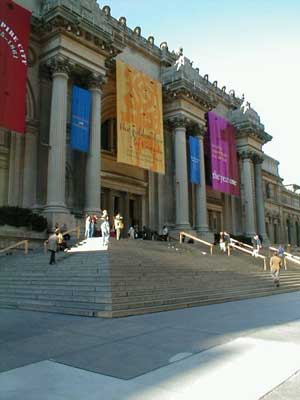The Original Drag King
 In contrast to the joyously beautiful spring weather we were having here in New York City, today was cold and dreary and ultimately very, very rainy. I spent some time perusing the Ashtanga EZ Board and emailing with friends. The kids played on their X-Box, and Lewis entertained us with his hound version of "fetch" (human throws the ball, hound runs after it, catches it on the first or second bounce and then chews on it until the human pulls it out of said hound's mouth; repeat). Did some online house-hunting as well. Westport is such a nice town. I'm really starting to yearn for wide-open spaces, the smell of the ocean (okay, maybe not the ocean, but at least the Long Island Sound), the ability to let my dog run out into the back yard to do his business....
In contrast to the joyously beautiful spring weather we were having here in New York City, today was cold and dreary and ultimately very, very rainy. I spent some time perusing the Ashtanga EZ Board and emailing with friends. The kids played on their X-Box, and Lewis entertained us with his hound version of "fetch" (human throws the ball, hound runs after it, catches it on the first or second bounce and then chews on it until the human pulls it out of said hound's mouth; repeat). Did some online house-hunting as well. Westport is such a nice town. I'm really starting to yearn for wide-open spaces, the smell of the ocean (okay, maybe not the ocean, but at least the Long Island Sound), the ability to let my dog run out into the back yard to do his business....
Anyway, late in the day, Adam and I walked over to the Metropolitan Museum of Art to check out the Hatshepsut Exhibit. Hatshepsut was a female ruler of Egypt about 4,000 years ago. But instead of being queen, she became king - or Pharoah - a title you have heard about a lot if you've been reading this blog in the past few weeks. I am not sure how Adam and I came to decide that we wanted to see this exhibit, but I can tell you this: it was definitely Adam's idea, and it was definitely Adam who pushed for it to happen. Oh! I am kvelling!!
In brief, the story is as follows:
Hatshepsut was the daughter of the Pharaoh, Tuthmose I. When Tuthmose I died without sons, Hatshepsut ascended to the throne as a sort of Queen Mother to her nephew, Tuthmose III, who was technically next in line for the throne, but too young to ascend. She ruled for 15 years, pretty much acting as the boss of Tuthmose III, using propaganda and keen political skills, to overcome the hurdle of being a girl in a man's world. To quell the fears of her people, she became a "king" in all statuary and relief during her reign. She even dressed in men's clothing and wore a "false beard", at least in the statues she had commissioned of herself, which are the subject of the Met's exhibit.
I am sure I have mentioned this before, but Adam is really, really interested in ancient history. This has expressed itself in an interest in bible stories and the more character-driven stories behind certain Jewish Holidays, such as Hanukah, Purim and Passover. I share Adam's interest in history - not just ancient history, but all history really. Most of the books that I don't end up abandoning halfway through are more or less "historical" fiction (for example, The Red Tent, which I finished this past week, and Memoirs of a Geisha, which I finished a few months ago). So, not only was I doing my parental duty in taking my child to a museum, but I was quite excited to see this particular exhibit, particularly since I had just finished The Red Tent, which takes place, at least in part, in ancient Egypt.
As we walked along 79th Street toward Fifth Avenue, I realized that it has been several years since I had walked into the Met, and it was probably the first time I had ever been to the Met with Adam. Back when Brian was a newborn, I used to take him there all the time. That was early 1997, and an article in Newsweek had recently come out about the "Zero to Three" years, and how important they were in a child's mental and emotional development. At the time, I was a full-time working mom, and this Newsweek article, which EVERYONE was talking about at the time, shook me to my core and put the fear of God in me that I had better spend every waking moment stimulating Brian's brain. So, starting before he was even able to focus beyond six inches in front of his face, I used to bundle Brian up in the Baby Bjorn and walk around the Met. We went so often that it made good financial sense to purchase a family membership, which we kept renewing until about a year ago, when I finally faced the fact that we were no longer visiting the Met with any regularity. Or even at all. Except maybe to buy a hot dog or a pretzel on the way into Central Park.
Met with Adam. Back when Brian was a newborn, I used to take him there all the time. That was early 1997, and an article in Newsweek had recently come out about the "Zero to Three" years, and how important they were in a child's mental and emotional development. At the time, I was a full-time working mom, and this Newsweek article, which EVERYONE was talking about at the time, shook me to my core and put the fear of God in me that I had better spend every waking moment stimulating Brian's brain. So, starting before he was even able to focus beyond six inches in front of his face, I used to bundle Brian up in the Baby Bjorn and walk around the Met. We went so often that it made good financial sense to purchase a family membership, which we kept renewing until about a year ago, when I finally faced the fact that we were no longer visiting the Met with any regularity. Or even at all. Except maybe to buy a hot dog or a pretzel on the way into Central Park.
(P.S. Turns out, Brian is a GENIUS....was it the trips to the museum? the Gymboree classes? the long walks down Second Avenue, with its lights and noise and smells and bustling activity? my constant talking? or is it...just Brian?)
Anyway, so, Adam and I went to the Met. And first thing, he complained that there was no King Tut exhibit. That cracked me up because I think, although I am not quite sure, that my parents DRAGGED me to see the Tut exhibit when I was about Adam's age, and I hated every single minute of it. Then we went to see the mummies in the Ancient Egypt room. Adam was surprised to see that the mummies were wrapped in silk, with their limbs pressed against their bodies, and that they wore masks. I think he was expecting them to be wrapped in white gauze with their arms and legs free. He did tell me, in case I was wondering, that he was not scared.
Adam also told me that he was very offended by all of the idols he saw. "I HATE idols," he told me. "Why?" I asked. "Because I'm Jewish, and we don't worship idols." I explained to him that he doesn't have to hate idols to not worship them. He can simply not worship them. Later on, he got confused and thought that a Rodin sculpture was an idol. But I digress.
Our last stop at the museum was our real reason for being there, of course: the Hatshepsut Exhibit. Upon arriving in the gallery, Adam told me that he wanted one of those personal audio things so that he could listen and learn about the exhibit. I was like, sure, of course, as long as you tell me what you learn. We negotiated a bit, and it was agreed that he would tell me ONE thing that he learned about each piece that the audiotape talked about. The first piece, and by far, to me, the most compelling was this one:
What Adam told me was that this statue of Hatshepsut is significant because of her stance. Women of Hatshepsut's day would pose with their arms by their sides (he demonstrated this for me). But here Hatshepsut stands in the traditional stance taken by male rulers: left leg steps forward; palms face down. She is also wearing a "false beard" (not to be confused with a "fake beard", according to Adam, although I really don't see the difference, myself). Adam pointed out for me Hatshepsut's cartouche, explaining to me what various symbols meant. He also pointed out for me a "false door" to the palace which is significant because it shows where ultimately Hatshepsut's cartouche was scratched out and replaced by that of her father, the prior Pharoah. The same is true of a number of other pieces in the exhibit - it seems that someone tried to erase Hatshepsut from history. It is believed that it may have been her co-King, Tuthmose III. However, evidence points to a conclusion that if Tuthmose III was responsible for ordering the obliteration of Hatshepsut from history, it may have been the result of political pressure, as opposed to jealousy or bitterness. Anyway, that's what Adam tells me.
The yogi in me must mention at this juncture that before we moved onto the next part of the exhibit, I asked Adam to join me in standing in the same pose as the statue. I thought about whether it would make a good yoga pose. Not a particularly difficult one. But an interesting one nevertheless.
Obviously, I found the Hatshepsut exhibit to be inspiring, at the very least. In fact, I found it to be quite a fascinating exhibit, and I thanked Adam profusely for getting me back to the Met. I am so proud of him. Did I say that already?
And I am so lucky to have this world-famous museum practically in my backyard.
Back to yoga tomorrow....
YC








3 comments:
Adam is a genius in his own right.
Yes, he is. Which just goes to prove that it's not all the neurotic stuff that I did as a first time mom that made Brian the way he is. It's the genes! ;)
Hey, thanks for blogging that! We tried to see that exhibit when we were in NYC but it was a members' only preview day. Now I know what it was about!
My overly coddled and stimulated first-born son is a genius, but my benignly neglected second-born daughter is even more of a genius...I think all the Gymboree and baby music classes addled his brain.
Post a Comment